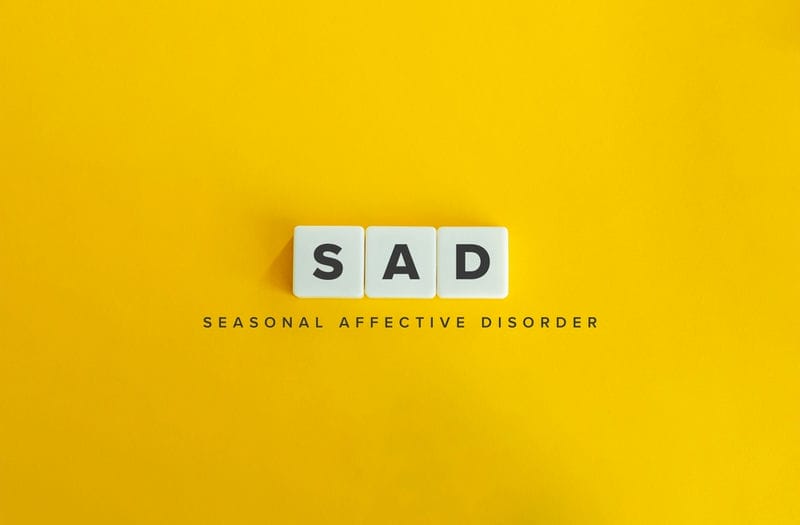Now that the dark nights are drawing in and that familiar chill is back, it’s time to talk about Seasonal Affective Disorder.
What is Seasonal Affective Disorder?
Seasonal Affective Disorder, or SAD, is a type of depression that tends to follow a seasonal pattern. Typically, SAD is known as the ‘winter depression’ or the ‘winter blues’ as symptoms often worsen during the winter months.
Receiving a diagnosis of SAD might be more common than you think. The NHS estimate that around 2 million people in the UK are affected by SAD, as are a further 12 million people across Europe. Given there are almost 68 million people in the UK, that means nearly 3% of the UK population live with SAD.
What are the symptoms of SAD?
Although symptoms vary between individuals, some of the most common symptoms of SAD include:
- Feeling persistently low mood
- No longer being interested in or getting pleasure from normal everyday activities.
- Feeling less sociable
- Irritability
- Lacking energy (feeling lethargic) and sleeping during the day
- Sleeping for longer than normal and struggling to get up in the morning.
- Eating more, craving carbohydrates, and gaining weight
- Finding it harder to concentrate
- Being less interested in sex
The severity of symptoms also varies and for some people, SAD has a significant impact on their daily living and ability to carry out everyday activities.
What causes SAD?
Unfortunately, the exact causes of SAD are unknown, however the main theory is that the lack of sunlight during the autumn and winter impacts the way an area of the brain works.
The hypothalamus is responsible for lots of things but during the winter, if it stops working as well, it can impact:
The production of melatonin, which is the hormone that makes you feel sleepy. People with SAD often produce higher than normal levels of melatonin, which is why sleeping too much or struggling to get out of bed is common.
The production of serotonin, which is the hormone known to impact mood, appetite, and sleep. Unfortunately, a lack of sunlight can cause lower serotonin levels, which can result in feelings of depression.
The circadian rhythm, which is otherwise known as your body’s natural clock. As your body clock is run by natural light, during the winter when there is less daylight, it can become disrupted.
Tips and tricks to help manage SAD.
Although the stats around the number of people who live with SAD might seem a bit, err, depressing, we have some tips and tricks to help.
In true Xpert Psychology form, we have done the hard work for you and have put together a list of the most recommended self-help tips. As it’s us, you can be sure we have checked out the evidence base and consulted guidance from the National Institute of Health and Care Excellence (NICE).
- Get outside (get outside, get outside)
We can’t stress this one enough, but getting outside in the natural daylight is so important. You should try to get outdoors as much as possible, and if time is a bit tight, try to aim for around midday, particularly on bright and sunny days. Also, try to sit by a window whenever you can.
Tip – why not try to factor in a lunch break at 12.00pm each day and go for a walk outside. Not only will this mean you get to lap up the natural daylight, but it is also likely to help create balance during your working day as you are enforcing time away from your desk. This will also help you manage your stress levels at work and reduces the risks of burn out. (will send another blog on this to link to)
- Walking, jogging, running… anything to keep active
We know it’s a bit of an old classic but seriously, keeping active, at whatever level you can manage, is such an important part of tackling those winter blues. In fact, research has shown that the effectiveness of a 1-hour midday walk is likely to be on par with light treatment for SAD.
- Light therapy
Some people find that light therapy helps alleviate symptoms of SAD. Light therapy involves sitting in front of a light box for 30-60 minutes each day. Light boxes are at least 10 times stronger than any light you will find at home or in an office, and they work by mimicking natural light. Although light boxes are not readily available on the NHS, you can purchase your own for as little as £30 online. If you are going to try it, research shows it is most effective when used in the morning.
If you are considering light therapy and you have any condition or take medication that makes you sensitive to light, be sure to check with your GP whether therapy is suitable for you.
- Being with friends and family
Spending time with people you care about and those who have a positive impact on your life is a bit of an all-rounder for improving your mental well-being. We know it can be tough keeping up with the social calendar over winter, but accepting invitations can help to give the winter structure. What you decide to do is up to you, but anything from walks with friends (and of course fur-friends), grabbing a coffee or a quick bite to eat, attending your local book club or volunteering for a charity, are all great uses of your time. Even if you only feel like going for a short amount of time, being with people you care about (and who care about you) and doing things that ordinarily you enjoy has been shown to help symptoms of SAD.
- Talking therapy
Psychological therapy, particularly Cognitive Behavioural Therapy (CBT) is known to be an effective treatment for SAD. You might say we are biased given we are a bunch of clinical psychologists but seriously, NICE guidance states that SAD ought to be treated in the same way as other types of depression, and you guessed it, talking therapies is always one of the top two treatment recommendations.
CBT will help you to understand that the way you think and behave impacts the way you feel. With support, you will learn how making changes to the way you think and how you respond to certain situations can change the way you feel.
When should you see your GP?
If you’re struggling with SAD, or you think you might have it, you should consider seeing your GP. They will complete an assessment of your current difficulties, your lifestyle and your medical history and will make some recommendations based on what they think will help. For some people, in addition to the things we have suggested, treatment may also include antidepressant medication. Talk this through with your GP and they will support you to make the best and most informed decision about your care.
Looking for help?
If you are looking for help with your mental health and want to explore talking therapies, why not click here and head over to our website and check out what our brilliant group of clinical psychologists offer.
For more tips and tricks, look at our Instagram page, or our YouTube and TikTok account for video content.
Please note, we do not offer an emergency crisis service. If you need support or are worried about somebody, contact NHS 111 option 2, Samaritans 116123, or text Shout to 85258. If you need emergency support or your situation is life-threatening, visit your local accident and emergency department. Help is always available.

